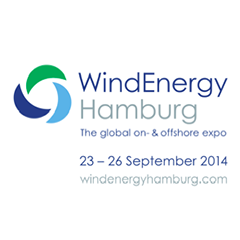WindEnergy Hamburg – The global on- & offshore expo at the Hamburg Fair site from 23 to 26 September 2014
Hamburg, 15 May 2014/ WEHH4. Offshore wind farms present special challenges for plant builders, project designers and service providers. But they deliver power practically all the time, 24 hours a day, on an average of 340 days a year. So offshore wind energy has a key part to play in the energy mix. That is why offshore wind farms are planned even by countries which have enough wind turbine locations available on shore. WindEnergy Hamburg, from 23 to 26 September, will feature a wide range of globally operating manufacturers, equipment suppliers, planners and project designers presenting their projects for solutions for the offshore wind industry. They include numerous exhibitors from the shipbuilding industry that have also exhibited shortly before at SMM Hamburg, the world’s leading maritime industry. Experts from these two industries can exchange experience on offshore projects and obtain business leads in new fields of activity. So the leading international wind energy expo is also the biggest event for the offshore wind industry. Leading suppliers from all parts of the world will present their innovative solutions for the challenges of this industry in Hamburg, the capital of the wind industry.
The trend among turbine manufacturers is towards ever larger, ever more powerful systems. Wind turbine suppliers Alstom, Senvion, and Siemens will explain their latest 6MW+ class models, all with super-size 150m+ rotor diameters. The Alstom and Siemens direct-drive turbines incorporate a permanent magnet generator, but offer different drivetrain solutions. Siemens also provides information on a new 4MW SWT-4.0-130 turbine succeeding the 3.6MW model. Senvion’s 6.2MW 6.2M152 also features a new cast main carrier, while retaining a proven double fed induction generator. AREVA Wind’s new 5MW Multibrid M5000-135 with enlarged 135-metre rotor diameter is the M5000-116 successor model. Gamesa introduced a new 5MW G128-5.0MW medium-speed turbine, and established an offshore wind business cooperation with AREVA Wind last year. Visitors can be informed on the cooperation status and future products direction. Earlier this year Vestas installed an 8MW V164-8.0MW medium-speed prototype, and can also inform Hamburg visitors about progress in the joint venture with Mitsubishi.
Aerodyn subsidiary Super Compact Drive has developed 6MW and 8MW two-bladed medium-speed downwind turbines. The 6MW SCD 6.0 is licensed to MingYang of China, while the 8MW version is aimed at European offshore markets. Two-bladed turbines are still new in the market, but offer multiple potential benefits with regard to easier transport logistics, single nacelle and rotor hoisting, and helicopter landing on the nacelle.
Cost saving potential for foundations
Cost-effective wind turbine foundation design and installation is key in driving down lifecycle-based cost of energy. New product developments presented in Hamburg range from XL-type monopile foundations, to gravity based and the latest jacket solutions. Hamburg exhibitor EEW SPC has already produced an XL monopile with 10-metre outer diameter, and Danish utility Dong Energy has developed a jacket system using suction buckets. Dutch company Van Oord co-developed a self-buoyant hybrid foundation comprising a concrete caisson base with a steel shaft. The base is cast onshore and installed into position offshore using standard vessels, thus avoiding the need for heavy-lift equipment.
German engineering consultancy Gicon is one of several international parties developing various floating foundation designs. The GICON-SOF is a tension leg platform (TLP), but characterised by vertical and diagonal tension cables for enhanced stability. In many deep-water regions of the world like the Mediterranean Sea, floating foundations could be the only option available for offshore wind.



























